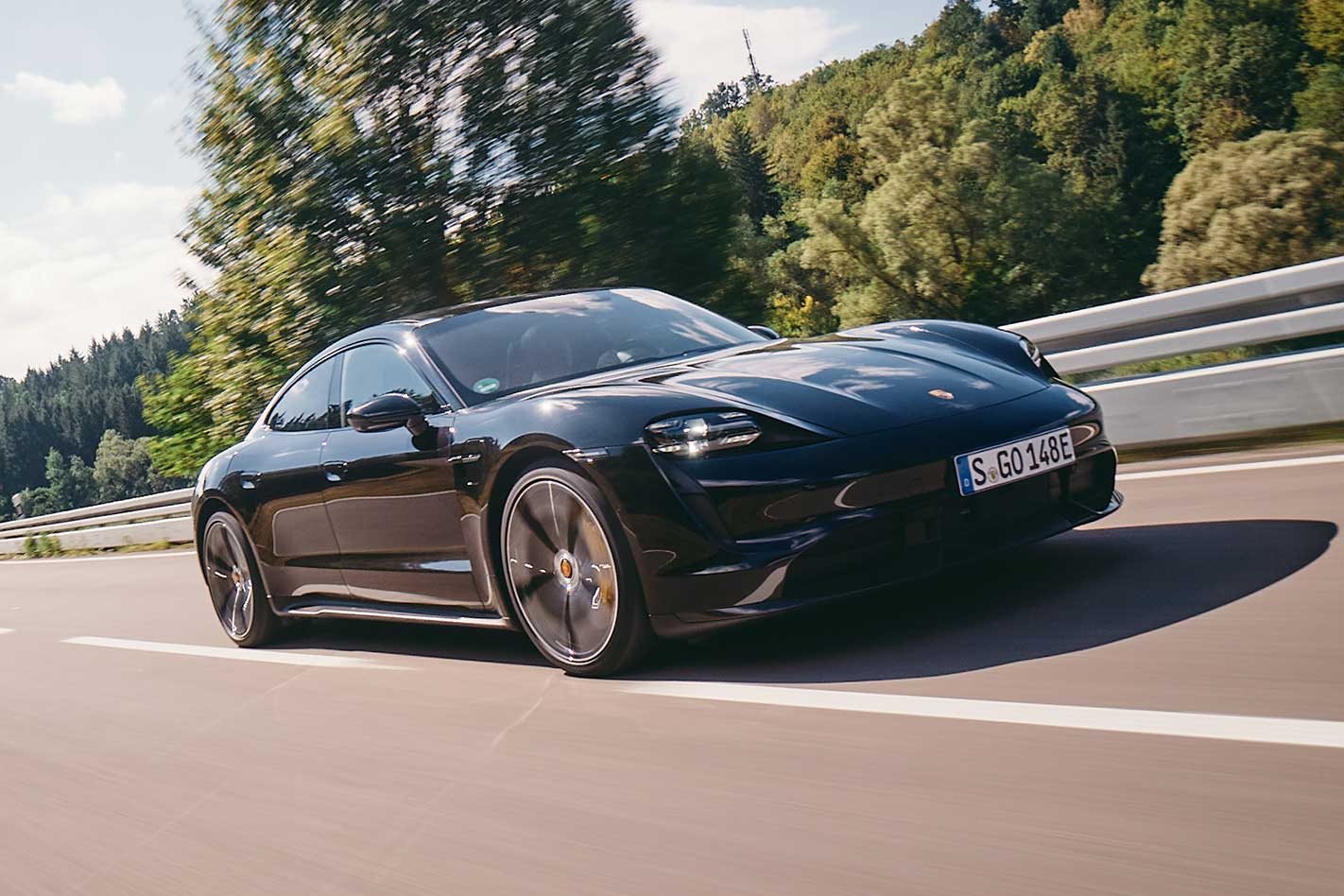The first fully electric Porsche is an object lesson in vehicle dynamics, repeatable performance and overall user-friendliness.
Boasting strong looks inspired by the 911 and a seriously advanced drivetrain, the high-end five-door Porsche Taycan EV is an evolution of the plug-in Panamera with the soul of a new-age sports car. And if the proof is in the pudding, the time has come to gorge on this technical tour de force.
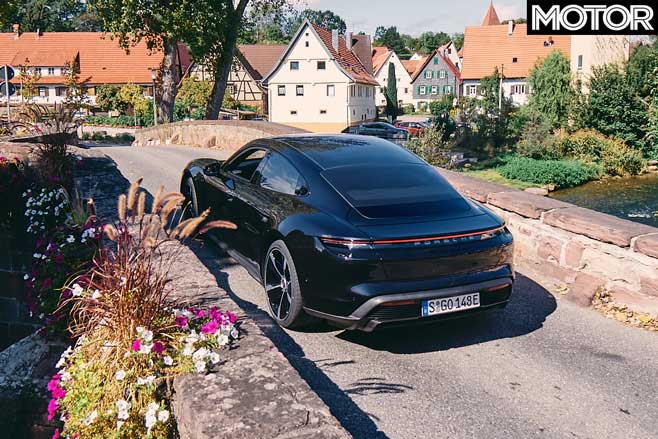
As I approach, my alter ego is busy scribbling down the first mental notes. The driver seat looks as if it is mounted a long way down, and is actually level with the 992 Carrera, so the bones must bend to a Z before they can stretch again.
Where the ignition key used to be, a flush-fitting starter button impatiently awaits the first command of the day. To the right is a three-way gear selector that resembles a micro joystick; up for reverse, down for drive and in the middle for neutral.
The main instrument binnacle is a digital reinterpretation of Porsche’s first five-dial layout, the centre stack an iPad metamorphosis designated to access the climate control functions, the rectangular monitor right above an iteration of the marque’s generic touchscreen.
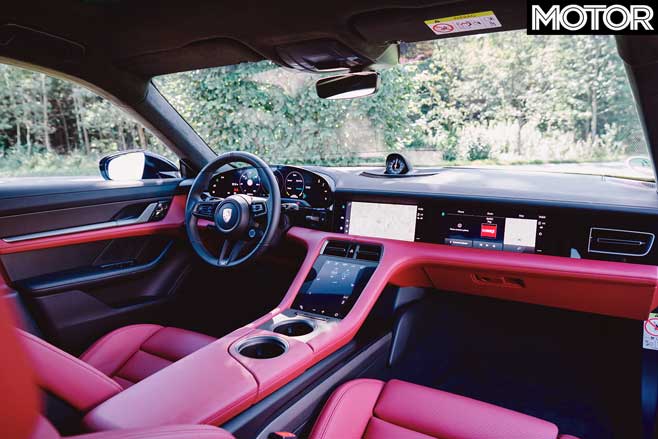
The first thing you notice when on the move is that this electric car is hush-quiet but by no means totally silent. Instead, it hums up to 30km/h to warn stray pedestrians; above 50 it invites the wind, the tyres and the suspension to join an improvised and constantly varying jam session; and, if you so desire, the street music can at the push of a button be accompanied by the virtual-reality Porsche Electronic Sport Sound back-up choir, which infiltrates the ears like a remix of Kraftwerk’s Autobahn and Mike Oldfield’s Tubular Bells.
In any other Porsche, noise works as a sure-fire aphrodisiac, but the Taycan merely plays a brief bi-vocal prelude, allows quadrophonic reticence to define the next movements, then lets an initially subdued crescendo herald the final furioso.
Blending in is the smacking of the sticky tyres, the metallic chirp of the carbon-ceramic brakes when still cold, the occasionally rumbling air suspension and that pitched full-throttle whir generated by two electric motors, two inverters and one limited-slip differential.

Unlike a 992 Carrera 4S, which happily produces its 331kW maximum all day long, this turbo-less Turbo S won’t be upset if you take the official performance figures with a pinch of salt. After all, the claimed peak of 560kW is exclusively available in overboost mode and only for 2.5sec. The ‘regular’ peak output of 466kW will start deflating after ten seconds, but by then you have reached 200km/h.
Key strengths against the equally quick Tesla S P100D are repeatability and consistency; it can do at least a dozen pedal-to-the-metal stints before dropping half a second, if that. At the same time, it’s perfectly capable of hammering along at 260km/h for miles on a clear stretch of autobahn.
While every bout of unbridled hooliganism is instantly reflected by the prominent range and state-of-charge readouts, the 800V system actively protects the batteries by making do with lower motor currents that have virtually no effect on the available power.
Depending on one’s driving style, Taycan passengers are either to be envied or pitied. Envy is the name of the game in full attack mode from a standing start, when this 2295kg neo-coupe sucks in and spits out the horizon.
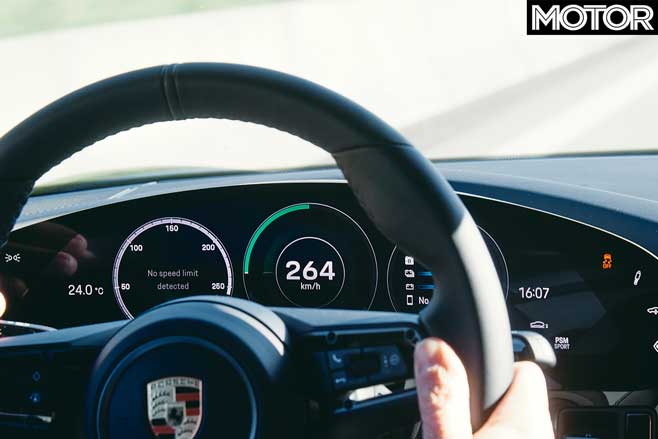
Pity is due when an unassuming occupant is suddenly caught out by the whiplash effect 1050Nm of torque invariably has on the small of one’s back, and on the longitudinal g-force that staples earlobes to the skull.
The familiar Drive Select knob on the steering wheel offers a wide span of attitudes marked as Range, Normal, Sport and Sport Plus. Range saves energy while teaching the driver how to play his part; Normal is exactly that; Sport holds first gear as long as possible; Sport Plus stages ultra-quick upshifts to match Porsche’s own PDK transmission down to the millisecond. As always, all four also tweak throttle response, suspension, steering action front and rear, anti-roll bar setting and ESP intervention.
This car stretches the imagination to a point where the black box inside your head switches to overload and begs for a reset. While the acceleration may not qualify for a new world record, the seamlessly physical kick-and-rush experience between 100 and 200km/h is amazing.
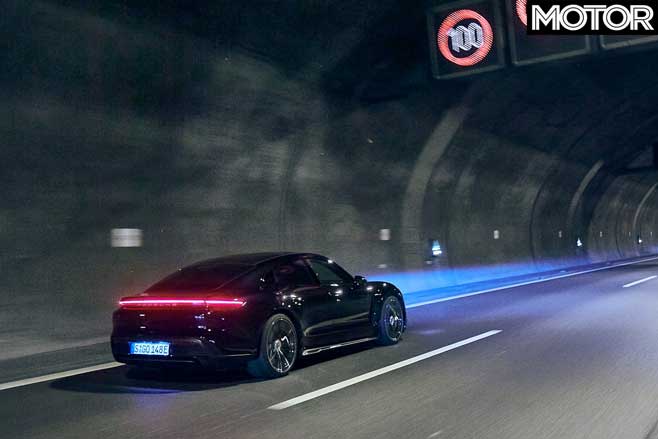
Roadholding, traction and grip are three more supernatural eye-openers. Helped by a centre of gravity that sits closer to the road than in a 911 – supported by a wide track and liquorice-compound 21-inch Goodyear Eagle GT tyres, aided by available adjustable sway bars, standard rear-wheel steering, forward-thinking torque-split system and megabyte master control unit – the Taycan Turbo S overwhelms with dizzying cornering speeds and cold-blooded composure.
It feels like an emission-free counterpart of the Audi RS7, generating a massive forward urge, putting the power down with fuss-free determination, and following the line as if guided by a super-precise master plotter.
In essence, that limit is defined by three parameters: the type of terrain about to be covered and the weather; the courage and skill of the driver; and the scary effect a hungry Taycan on the prowl might have on the law and on other road users.
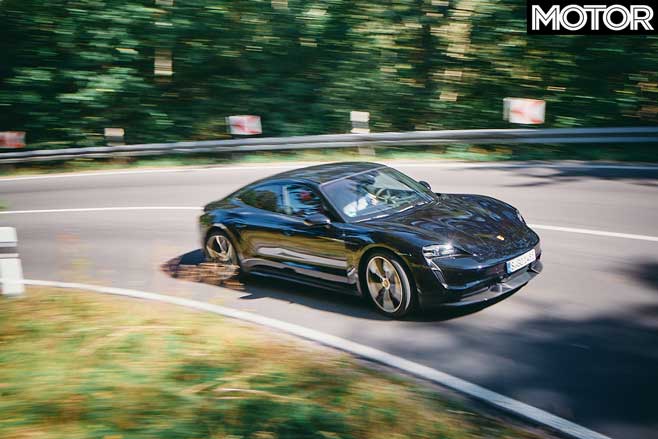
On a race track and in the snow, lurid slides are apparently as natural as clicking a finger. In traffic and on public turf, however, a heavy right foot and ESP in Dynamic Mode suffice to pop rivets off guardrails, peel white lines from the blacktop and make roadside posts bow in awe.
Thanks to an evenly balanced weight distribution, the purely electric AWD system and the sway bars’ ability to enhance or reduce oversteer and understeer, this Porsche seizes the road like a monorail.
Although it’s possible to dial in a more tail-happy attitude, catching the bulk before it answers the call of freedom requires little more than a quick flick at the helm. It’s an adamantly undemanding yet blindingly fast car low on fear and drama but high on efficiency and rapid ground-covering ability.
The sweet steering and strong brakes add more brownie points to the quickly consolidating grand total.
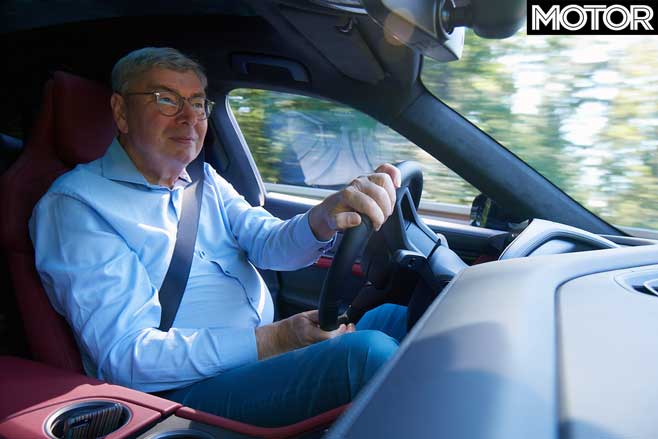
In contrast to every other electric car I’ve driven, it is impossible to decipher the exact moment when the Taycan’s stopping system switches from electric to hydraulic operation and back again. The brake performance is accordingly linear, pedal pressure is by and large in sync with the slow-down effect it triggers, and there’s always plenty of surplus strength on tap, either to reel it in or to feed the ever-peckish batteries with regenerated energy. The only minor criticisms concern a slightly wooden pedal feel above 200km/h and the extra final-yards effort it takes to bring this heavyweight to a full stop.
The rear-wheel steering reduces the turning circle by 0.5m to 11.2m and the electric rack-and-pinion is quick but not restless, relaxed but not wayward around the straight-ahead, communicative but not chatty, light but not vague. It puts all that weight, power and grunt into your palms in a manner that shouts reward rather than challenge, and precision without the faintest trace of overkill.
In terms of confidence-building ability, this Porsche scores a solid ten out of ten.
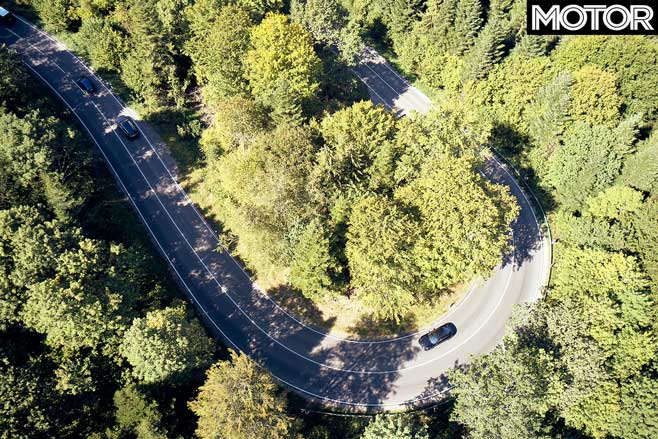
When Audi, BMW, Jaguar or Mercedes promote the benefits of their latest EVs, the notorious one-pedal feel pops up as a highly important asset. According to Porsche, however, the lift-off effect should never feel as brusque as if someone had pulled the handbrake.
While other EVs offer up to four energy regeneration modes, Porsche relies on a single program that is subtle enough not to disturb the forward motion and can easily be disengaged by pushing a button on the wheel.
If our test car is anything to go by, the official performance and range data are quite conservative. According to the on-board computer, there is a 56km distance-to-empty buffer hidden in the data sheet. The claimed average consumption of about 25kWh seems equally overcautious.
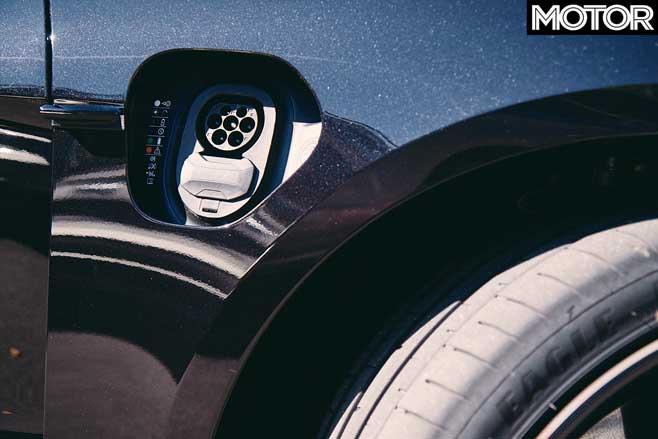
The instant you nail the accelerator and drive the Taycan like a petrol-fed Turbo S model, these projections are voided. But so what? Dawdling along at 100km/h with over 500kW on tap sums up the proverbial anti-climax experience. Instead, why not select Sport Plus, disconnect the silly here-we-come sound processor, lock stability control in play mode, put on the imaginary helmet and swallow a couple of bastard pills.
Zero to 200 in 9.8sec? Done that. Smokey burnout with ESP off? Check. Flat-out on the autobahn at an indicated 268km/h? Yep. Kick the instant consumption readout to 50kWh where the scale ends just for the heck of it? You bet. Monitor blood pressure and heart rate? Can’t do it on the move, but all the body’s own scanners, antennae and sensors are still operating well within their comfort zone.
How can this be when you’re flat-out in a Porsche that rips the tarmac, dishes up more combined instant torque than any other product of the brand, and has high performance written all over its black stealth body? The answer is, in blunt terms, because effortlessness and efficiency are prone to outweigh excitement and emotion.
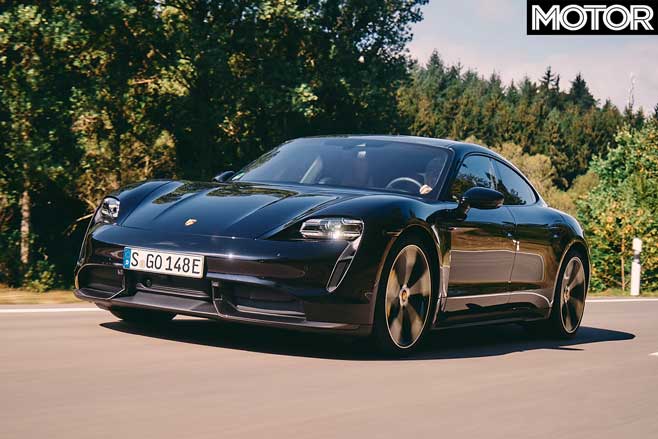
Although the Taycan Turbo S performs like a Porsche, its Porscheness does not always ring through loud and clear. Even compared to the Panamera with which it shares its three-chamber air suspension, the EV sister model feels somewhat softer-edged and slicker-moving. It turns high speed into an easily accessible property, juggles expertly its mass and weight, holds the road as if tied down by a set of magic magnetic fields.
It’s hard not to keep comparing this Porsche to the hottest Tesla Model S, which is on paper every bit as quick and just as fast overall, even though it can’t outhandle the Taycan. But is eclipsing a 10-year-old rival by not a huge margin really the milestone effort everyone expects from a brand new, potentially pace-setting Porsche?
There are several answers to this question. One could argue that long-standing parameters like power output, torque, acceleration times and top speed are not necessarily the defining must-haves of a modern EV. After all, the laws of physics prevent motor cars to catapult themselves from 0-100 in under, say, 1.6sec.
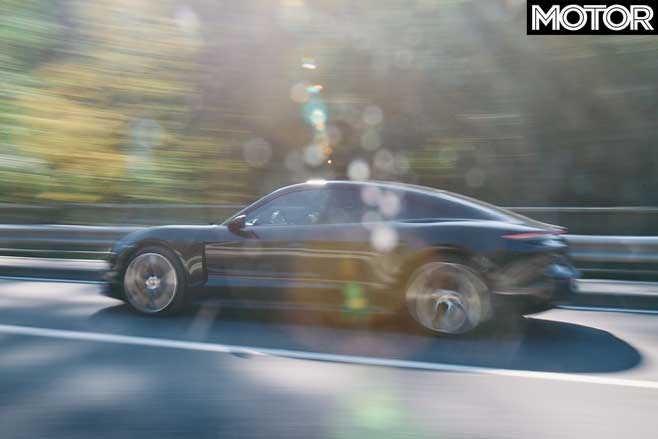
There is also very little 1500kW can accomplish that half as much would fail to fix. A similar deadlock applies to cell chemistry, range, consumption, energy density, battery life and charge times. Which leaves the character of the car in question and the scope of driving pleasure it provides as the major deal-making or deal-breaking qualities.
To broaden its appeal and sharpen its profile, Porsche could for instance develop a Range Plus version to close the evident gap in range – 414km for the Taycan Turbo S, a more calming 616km for the top-notch Model S. This difference is bound to hurt in markets like Germany where speed still matters.
Dedicated batteries, a low-drag body kit, narrower tyres, stronger motors and matching performance electronics could also work wonders in an environment where maximum range is more important than momentary peak power.
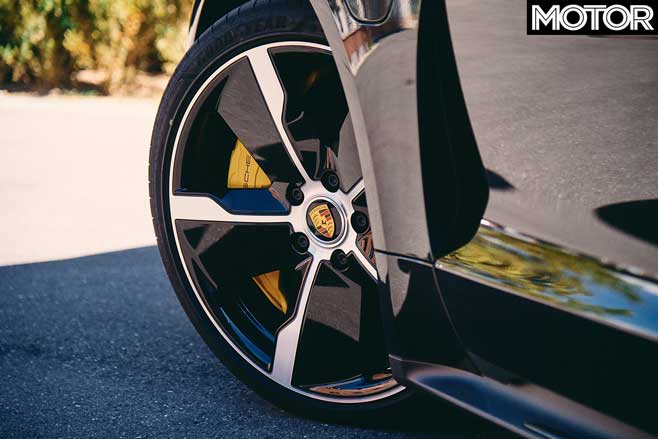
If speed is a drug, then the Taycan Turbo S gets you hooked in one easy lesson. But many industry observers believe that there are more facets to the ultimate driving experience than sheer velocity.
Qualities such as involvement and interaction, which put a stronger emphasis on car control at the highest level and on best-in-class handling. There is one sure-fire way to accomplish these goals, and that’s by signing off a lightweight rear-wheel-drive Taycan GTS that could perhaps even retain the decontented front axle of the Turbo.
A two-wheel-drive derivative would be less portly, a large portion of the weight would sit on the driving wheels, and by allocating one motor to each driveshaft, a combined output of 350kW-plus would be within easy reach. Such a less-is-more product would bring out the sports car genes, function as credible differentiator to the competition, and help redefine core brand values.
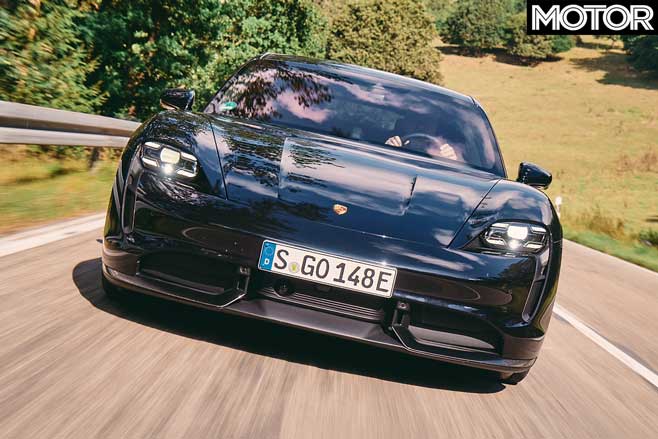
The Taycan is a very good car – and so it should be considering the 202,000 Euro ($A328,000) price of the black specimen shown here. The Turbo S is on an equal footing with the ludicrous Tesla as far as one-time performance goes, but it does carve out a progressively growing lead by repeating the action time after time.
Traction, grip and roadholding are also little short of sensational, steering and brakes leave almost nothing to be desired, the redesigned self-explanatory ergonomics are a big step in the right direction, cabin and luggage space are okay but not brilliant, the promised charge times are about to set a new industry standard, and even the ride is surprisingly supple.
Owners will probably spend the first few months marvelling with pride and delight at the explosive yet totally laidback torque deployment, the awesome punch packed by all that power, and the cocoon effect of this eco-friendly zero-emission weapon. But sooner or later there will come a point when mere perfection won’t suffice anymore, which is why Porsche may be well advised to spin a fresh yarn before Tesla introduces an even more colourful upgrade.
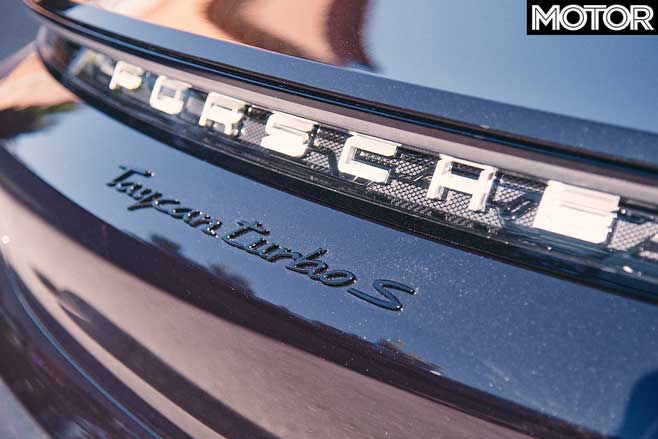
FAST FACTS 2020 Porsche Taycan Turbo S BODY: 4-door, 4-seat liftback DRIVE: all-wheel MOTOR: Two permanently excited synchronous BATTERY: 93.4kWh POWER: 560kW TORQUE: 1050Nm WEIGHT: 2295kg POWER-TO- WEIGHT: 244kW/tonne TRANSMISSION: 2-speed automatic SUSPENSION: double wishbones, air springs, adaptive dampers, active anti-roll bar (f); multi-links, adaptive dampers, air springs, active anti-roll bar (r) L/W/h: 4963/1966/1378mm WHEELBASE: 2900mm TRACKS: 1690/1655mm (f/r) STEERING: electrically assisted rack-and-pinion, rear-wheel steering BRAKES: 420mm ventilated carbon-ceramic discs, 10-piston calipers (f); 410mm ventilated carbon-ceramic disc, 4-piston calipers (r) WHEELS: 21.0 x 9.5-inch (f); 21.0 x 11.5-inch (r) TYRES: Goodyear Eagle F1; 265/35 ZR21 (f), 305/30 ZR21 (r) PRICE: €202,000 ($A328,000)
PROS: Huge repeatable performance, handling, brakes CONS: Fake sound, weight, battery range, price RATING: 4.5 out of 5 stars

